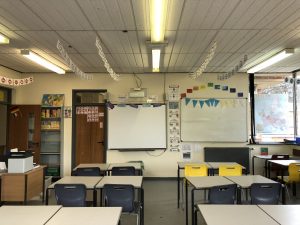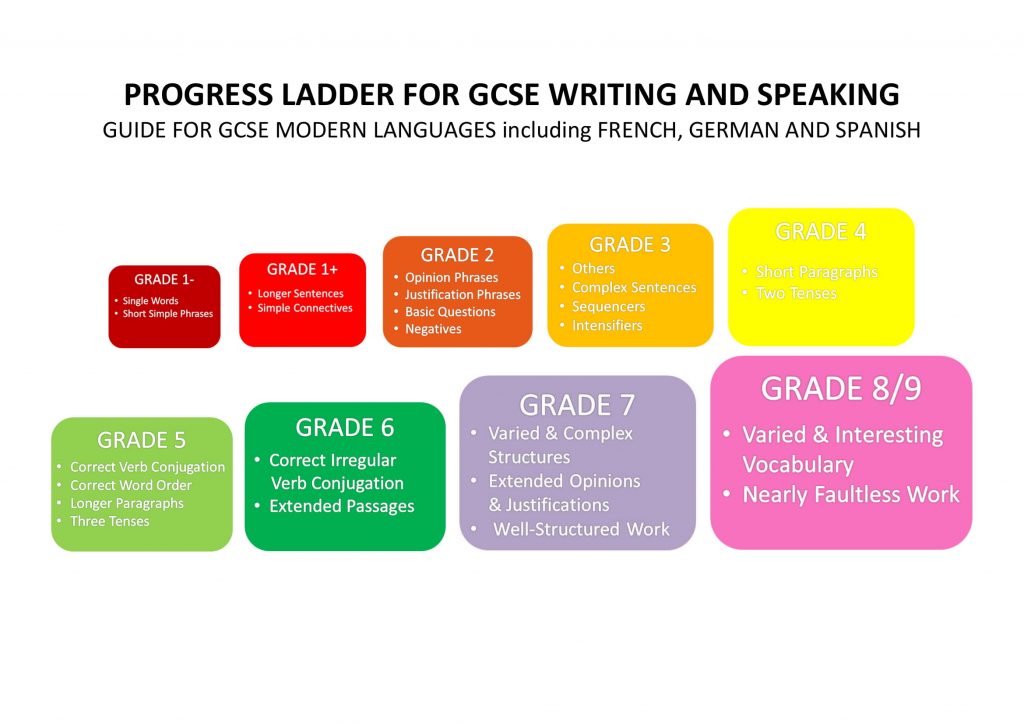 Progress is a key factor for language teachers and students in Modern Foreign Language at KS3 and KS4. Looking to spruce up your Modern Languages display with useful resources to improve students’ speaking and writing for GCSE Modern Languages, including French, Spanish and German? Read about our excellent MFL GCSE Progress Ladder Display for getting students to think about what to include in their speaking and writing examinations for MFL to get those all important marks…
Progress is a key factor for language teachers and students in Modern Foreign Language at KS3 and KS4. Looking to spruce up your Modern Languages display with useful resources to improve students’ speaking and writing for GCSE Modern Languages, including French, Spanish and German? Read about our excellent MFL GCSE Progress Ladder Display for getting students to think about what to include in their speaking and writing examinations for MFL to get those all important marks…
Speaking and Writing GCSE Modern Language Examinations
The writing and speaking examinations in GCSE Modern Languages count for 50% of the whole exam grade. This is, quite clearly, a significant percentage. However, I have found that students struggle to attain the best marks in these productive exams. I wanted to know why…
First of all, I considered the Assessment Objectives of the AQA GCSE Language Courses (including French, German and Spanish) which outline the following:
AQA Modern Languages Assessment Objectives for GCSE Speaking and Writing Examinations
- AO2: Speaking – communicate and interact effectively in speech
“All three parts of the test will allow students to demonstrate appropriate and accurate use of a variety of vocabulary and grammatical structures, including some more complex forms, with reference to past, present and future events. They will also allow students to use accurate pronunciation and intonation so as to be understood by a native speaker.” - AO4: Writing – communicate in writing
According to AQA’s scheme of assessment page, writing is marked against:
FOUNDATION (Grades 1-5): communication, content, quality of language, conveying key messages and application of grammatical knowledge of language and structures
HIGHER (Grades 4/5-9): content, quality of language, range of language, accuracy, conveying key messages and application of grammatical knowledge of language and structures.
This information is quite comprehensive. It illustrates what students should be communicating in order to meet the assessment objectives of the MFL GCSE course. So, obviously, this information needs to be shared with our learners. My school already shares these criteria with students, but last year many students still struggled to achieve the best grades in their writing and speaking tasks and examinations. Why?
Why Do Students Struggle To Achieve The Best Writing and Speaking Grades?
I started teaching in my current school in April 2017, with students’ GCSE grades ranging from 3-9. Upon commencing my new teaching post, I found that students could speak and write fairly accurately about any particular topic studied. They were mostly able to add different tenses, as well as some variety of vocabulary and some grammatical structures, which is what is outlined above. Unfortunately, they were still not achieving the grades they were capable of. After a little probing and analysis, I realised that students were unsure of what specific elements they could include to make their work stand out, as well as lacking examples of advanced vocabulary, structures and grammar that they should use. This is mainly what hindered them attaining the best grades. Does this sound familiar?
How Can Students Improve Their Speaking and Writing?

For the very reasons stated above, my department put together a progress ladder from grades 1- to grade 9 which outlines the different elements students should include to achieve the grade they are capable of. This is a reference point for students in the classroom at the front of the room, but is also stuck in their books at the beginning of the year.
We are enforcing learning and using the progress ladder from year 7 and have noticed that it has seriously boosted the grades that students are achieving from year 7 upwards. The students do need a regular reminder to use the elements, but all in all, it appears to be making a difference in the quality of the productive work produced.
Below, you will find the MFL GCSE Progress Ladder display that all MFL teachers have in their classrooms which is suitable for years 7 to 11, as well as a copy of the progress ladder for the reformed modern language GCSEs from Grades 1-9. What do you think about it? Leave me and other visitors a comment below!
Want a handy MFL GCSE progress ladder for students to put in their exercise books? If so, download the PDF version here > MFL GCSE Progress Ladder Display for Writing and Speaking (3309 downloads )
Need a MFL GCSE progress ladder to display in your classroom? Download the individual PowerPoint slides here > MFL GCSE Progress Ladder Display for Writing and Speaking for Classroom (2799 downloads )
https://www.aqa.org.uk/subjects/languages/gcse/german-8668/scheme-of-assessment
You might also wish to download my MFL marking sheet which can be used in conjunction with the MFL GCSE Progress Ladder for writing and speaking, which you can find here > KS3 French and GCSE French Writing Marksheet for Feedback
Join TheIdealTeacher.com’s mailing list below to keep up-to-date with the latest teaching activities and ideas!






One thought on “Progress in MFL Writing and Speaking GCSEs”